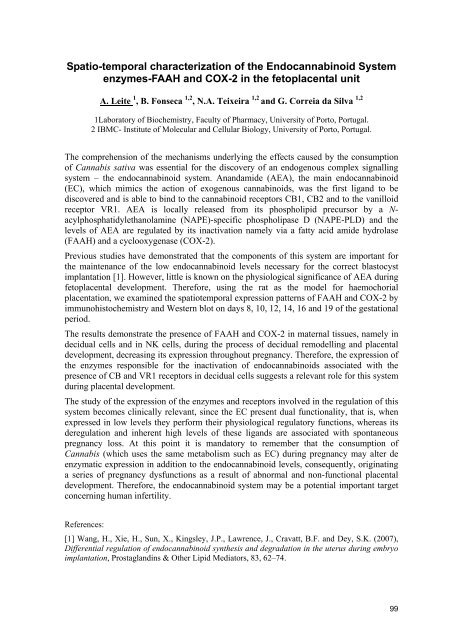IJUP08 - Universidade do Porto
IJUP08 - Universidade do Porto
IJUP08 - Universidade do Porto
- TAGS
- universidade
- porto
- ijup.up.pt
You also want an ePaper? Increase the reach of your titles
YUMPU automatically turns print PDFs into web optimized ePapers that Google loves.
Spatio-temporal characterization of the En<strong>do</strong>cannabinoid System<br />
enzymes-FAAH and COX-2 in the fetoplacental unit<br />
A. Leite 1 , B. Fonseca 1,2 , N.A. Teixeira 1,2 and G. Correia da Silva 1,2<br />
1Laboratory of Biochemistry, Faculty of Pharmacy, University of <strong>Porto</strong>, Portugal.<br />
2 IBMC- Institute of Molecular and Cellular Biology, University of <strong>Porto</strong>, Portugal.<br />
The comprehension of the mechanisms underlying the effects caused by the consumption<br />
of Cannabis sativa was essential for the discovery of an en<strong>do</strong>genous complex signalling<br />
system – the en<strong>do</strong>cannabinoid system. Anandamide (AEA), the main en<strong>do</strong>cannabinoid<br />
(EC), which mimics the action of exogenous cannabinoids, was the first ligand to be<br />
discovered and is able to bind to the cannabinoid receptors CB1, CB2 and to the vanilloid<br />
receptor VR1. AEA is locally released from its phospholipid precursor by a Nacylphosphatidylethanolamine<br />
(NAPE)-specific phospholipase D (NAPE-PLD) and the<br />
levels of AEA are regulated by its inactivation namely via a fatty acid amide hydrolase<br />
(FAAH) and a cyclooxygenase (COX-2).<br />
Previous studies have demonstrated that the components of this system are important for<br />
the maintenance of the low en<strong>do</strong>cannabinoid levels necessary for the correct blastocyst<br />
implantation [1]. However, little is known on the physiological significance of AEA during<br />
fetoplacental development. Therefore, using the rat as the model for haemochorial<br />
placentation, we examined the spatiotemporal expression patterns of FAAH and COX-2 by<br />
immunohistochemistry and Western blot on days 8, 10, 12, 14, 16 and 19 of the gestational<br />
period.<br />
The results demonstrate the presence of FAAH and COX-2 in maternal tissues, namely in<br />
decidual cells and in NK cells, during the process of decidual remodelling and placental<br />
development, decreasing its expression throughout pregnancy. Therefore, the expression of<br />
the enzymes responsible for the inactivation of en<strong>do</strong>cannabinoids associated with the<br />
presence of CB and VR1 receptors in decidual cells suggests a relevant role for this system<br />
during placental development.<br />
The study of the expression of the enzymes and receptors involved in the regulation of this<br />
system becomes clinically relevant, since the EC present dual functionality, that is, when<br />
expressed in low levels they perform their physiological regulatory functions, whereas its<br />
deregulation and inherent high levels of these ligands are associated with spontaneous<br />
pregnancy loss. At this point it is mandatory to remember that the consumption of<br />
Cannabis (which uses the same metabolism such as EC) during pregnancy may alter de<br />
enzymatic expression in addition to the en<strong>do</strong>cannabinoid levels, consequently, originating<br />
a series of pregnancy dysfunctions as a result of abnormal and non-functional placental<br />
development. Therefore, the en<strong>do</strong>cannabinoid system may be a potential important target<br />
concerning human infertility.<br />
References:<br />
[1] Wang, H., Xie, H., Sun, X., Kingsley, J.P., Lawrence, J., Cravatt, B.F. and Dey, S.K. (2007),<br />
Differential regulation of en<strong>do</strong>cannabinoid synthesis and degradation in the uterus during embryo<br />
implantation, Prostaglandins & Other Lipid Mediators, 83, 62–74.<br />
99










